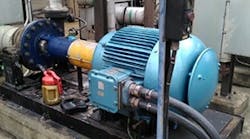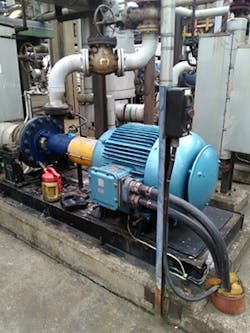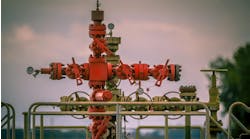A European refinery of a major multinational oil and gas company has 700–800 pumps that must be maintained in top working condition. The refinery was using a maintenance program based on “measuring vibration using micro-log data collectors and aptitude analyst software,” according to its key reliability engineer. However, this was proving to be expensive because the data loggers usually were just collecting data. “You can do detailed analysis with the data loggers but, most of the time, we were only doing condition monitoring, just checking the basic range and seeing how it’s trending,” the engineer notes.
So, the company began to explore using wireless technology. However, it soon realized that a Wireless HART network that could be integrated into the hard-wired instrumentation network already on-site would cost a lot.
The reliability team heard about i-Alert2, an economical, compact sensor that can be attached to any pump, motor, fan or other type of rotating equipment. The sensor contains everything needed to measure temperature, vibration in all three axes, and runtime. Newly updated firmware in i-Alert2 version 3 enables adjustable alarm checks every 1–5 minutes; the device can trend data from 1–60 minutes, and store hourly readings for 170 days. A smart phone or tablet can collect the data via Bluetooth from as far away as 30–100 ft (9–30 m).
The refinery installed a trial i-Alert2 unit in mid-2016. “We wanted to see how accurately the i-Alert2 sensor performed against a dedicated vibration analyzer,” says the engineer. “We set the parameters up to be exactly the same and there was virtually no difference in the retrieved spectrum. So we’re happy to diagnose off the FFT [fast Fourier transform] that we’re collecting from the i-Alert2.”
Figure 1. Compact unit can be attached to any type of rotating equipment
Tracking Down A Process Upset
The advantages of the i-Alert2 over conventional handheld vibration analysis only start with affordability. As the engineer explains: “With the data loggers, depending on how important or critical the pump was, we would go weekly, biweekly, monthly or quarterly. Then, we’d come back and analyze the data. This is what we call snapshot data. It’s only a pinpoint in time.”
The i-Alert2, on the other hand, provides an uninterrupted stream of time-stamped data. This ability to continuously monitor equipment made a decisive difference for the company on one critical pump — and proved its superior capability to the team.
After an i-Alert2 sensor had been installed on the pump, the team continued to take manual readings as well. Over a period of several months, the handheld vibration devices hadn’t detected any issues. However, when data were retrieved from the i-Alert2 device, a different story emerged. Those data clearly showed that a series of high-vibration events had occurred in between the handheld readings. When the pump was dismantled, the bearings were found to be very badly damaged and near failure.
“Initially, the blame for the bearing failure was apportioned to the pump manufacturer,” comments the engineer. “But then, I sent the i-Alert2 data to my process engineers and said: ‘Can you just have a look at all these time stamps and tell me if there were any process upsets anywhere on this unit?’ And they came back and informed me that, indeed, there were a series of steam upsets. You see, part of the refinery process is to inject steam to help separate light ends and heavy ends of crude oil. The steam had dropped from 1,500 kg/hr (about 3,300 lb/hr) down to about 400 kg/hr (about 880 lb/hr). So there wasn’t sufficient heat to separate the products. This pump takes that separated product and pumps it away — but if there isn’t the steam to create the separation, there is no product for it to pump. So, it runs dry. And that’s what caused the hyper-vibration.
“So, based on this i-Alert2 data, we could actually quite clearly pinpoint that there was a defect resulting from the process upset. And we were able to notify the operations guys and say: ‘You need to keep on top of the steam,’ which solved the problem. It’s all to do with an external source of influence, that being the process obviously. And that’s where i-Alert2 sensor really helped us.”
The insight on the root cause of the problem was invaluable; the return on investment for this trial sensor was instantaneous.
Properly understanding and addressing this problem kept a hazardous situation from arising. The consequences of such an event can’t be overestimated in a refinery, stresses the engineer. “Ordinarily, the energy is being used to push the fluid through the pipework, but when the pump would start to run dry, it’s not. So the only thing it can do is be generated into heat. That’s why we get high temperatures in the casings, which aren’t good for the seals either. Then your fluid in the pump is getting hotter and hotter, and, if it does break out through the seals, you’ve possibly already exceeded ignition temperature and then you’re into a fire situation. So it’s very critical that we make sure that we run these pumps at the right levels. The i-Alert2 gives us the ability to see when we have an issue like this.”
The site’s reliability team also is benefiting from the i-ALERT Asset Intelligence Platform. It’s a web portal that gives them a bird’s-eye view of all monitored assets at the refinery. As data are received, the platform stitches everything together, enabling the team to get a complete health history of their machines without going to multiple devices, screens or data sources. In addition, they can instantly call up advanced analysis tools including FFT and time wave forms on the platform. And because the team can view, assign and edit route activities from the portal, they can manage data collection more efficiently as well.
The team also appreciates how quickly updates can be made. “Sometimes messages pop up on the screen saying: ‘A new i-ALERT app is available, please download it.’ Because you’re running it through a web portal, you can do the changes overnight and the improvements are there. That is a huge selling point,” emphasizes the engineer.
Further Deployments
The refinery has installed about 100 units (Figure 1) so far, with the majority of those on pumps, aerators, compressors and fans. Based on the success the reliability team has been having with i-Alert2, they currently are contemplating adding more sensors at the refinery.
“Half of our plant is hydrofluoric acid,” says the engineer. “So you have to wear big rubber chemical suits to go in, which makes monitoring the machines very difficult. Then I thought, with i-Alert2’s range, I might just be able to reach the pump while standing outside the chained fence. So ,we went and installed it on one of the pumps. And we could connect to the i-Alert2 standing 25 m (about 80 ft) away and collect the data. For me, that was a real win-win.”
He concludes: “I can't see any product on the market that would do as much as well as the i-Alert2. It does exactly what I need it to do to help diagnose events and it’s affordable. For me, this represents everything that we need to deliver.”
ADARSH IYENGAR is global director, monitoring & controls, for ITT PRO Services, Seneca Falls, N.Y. Email him at [email protected].



